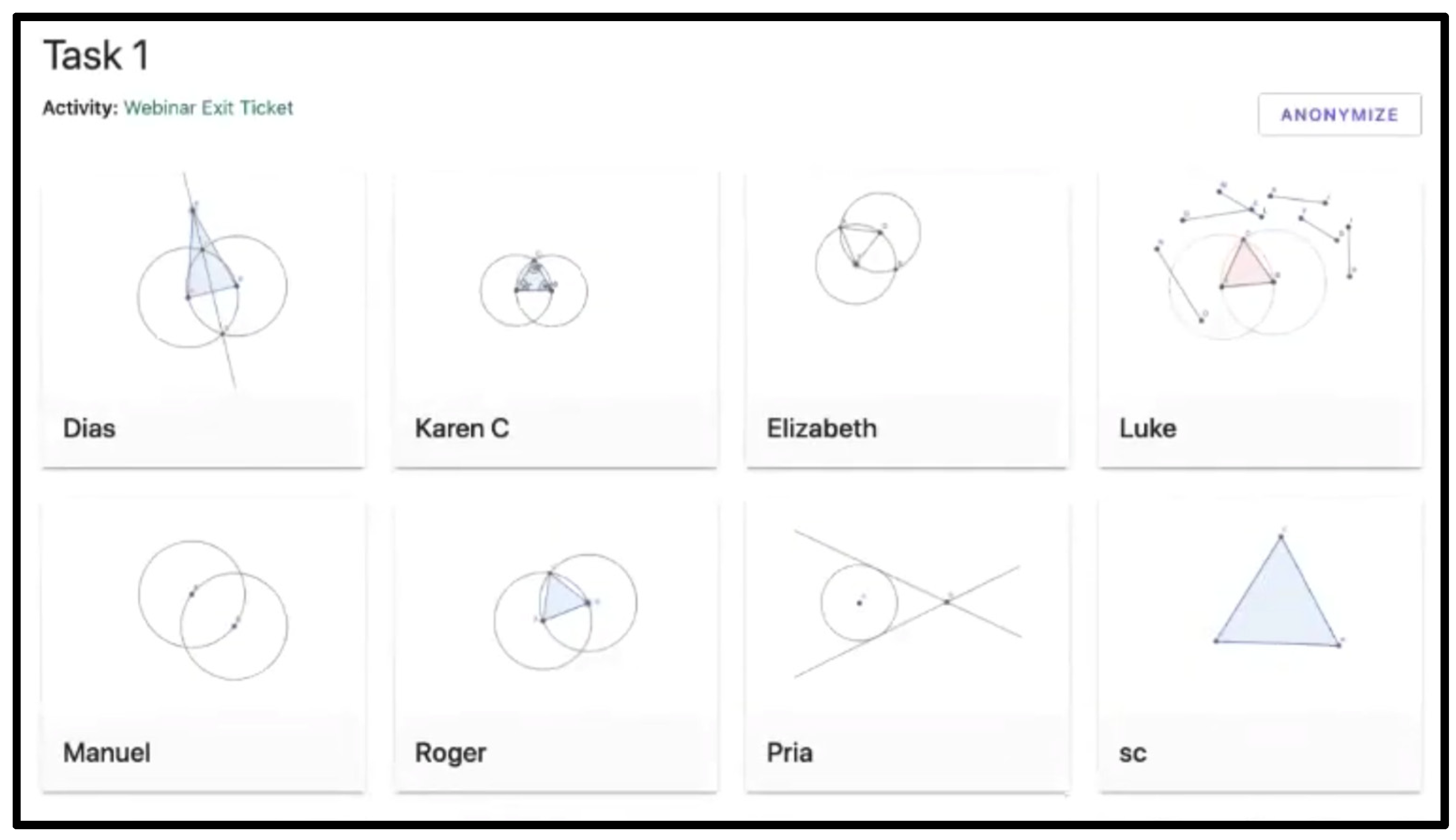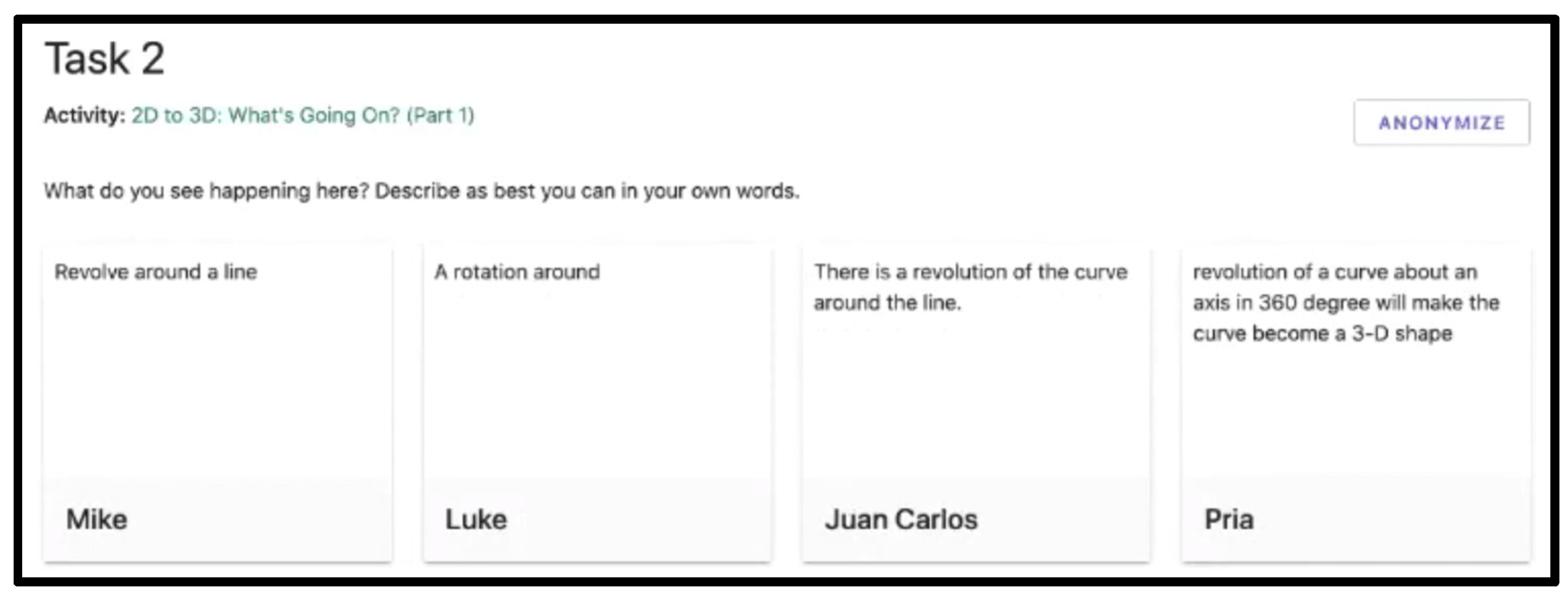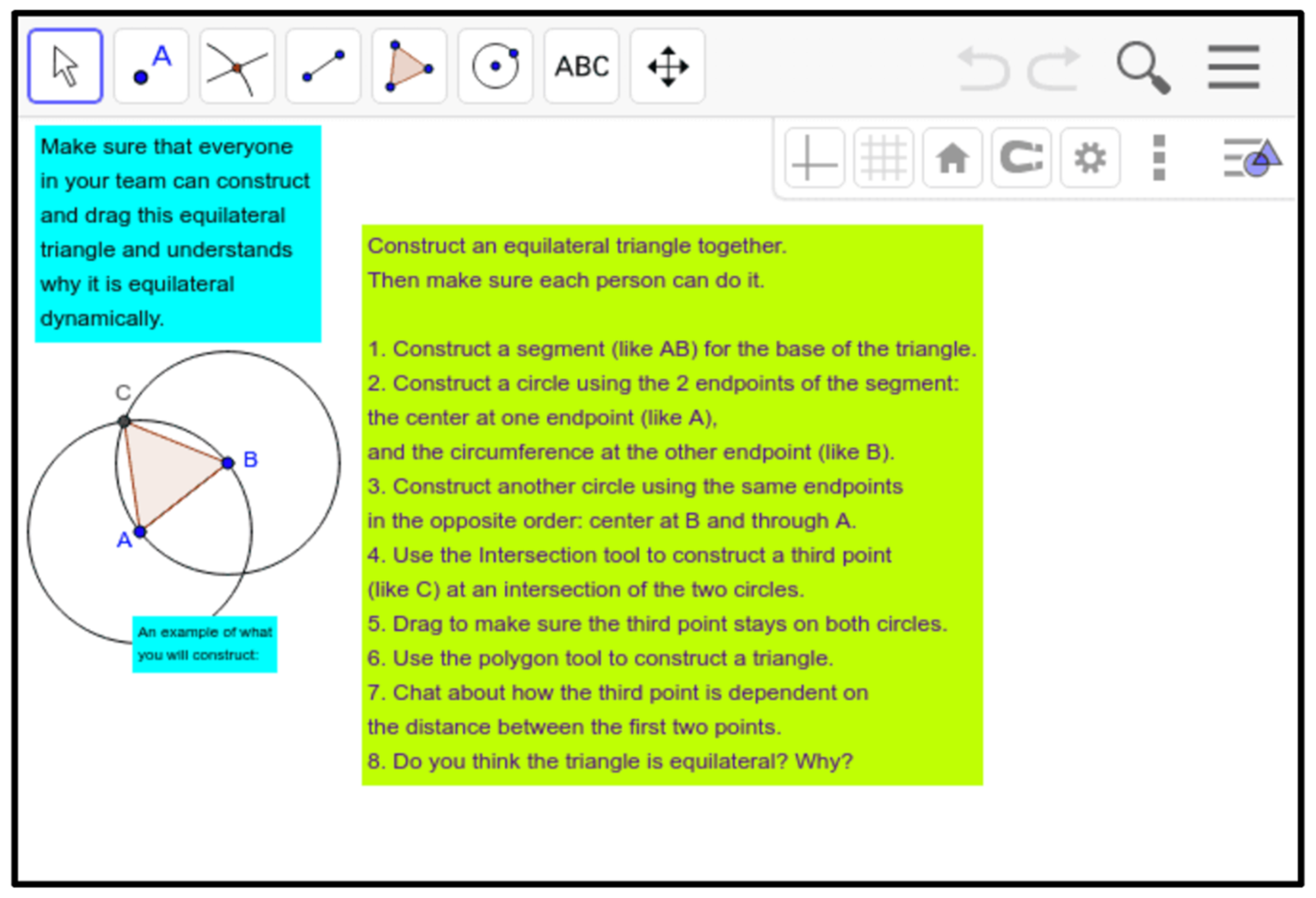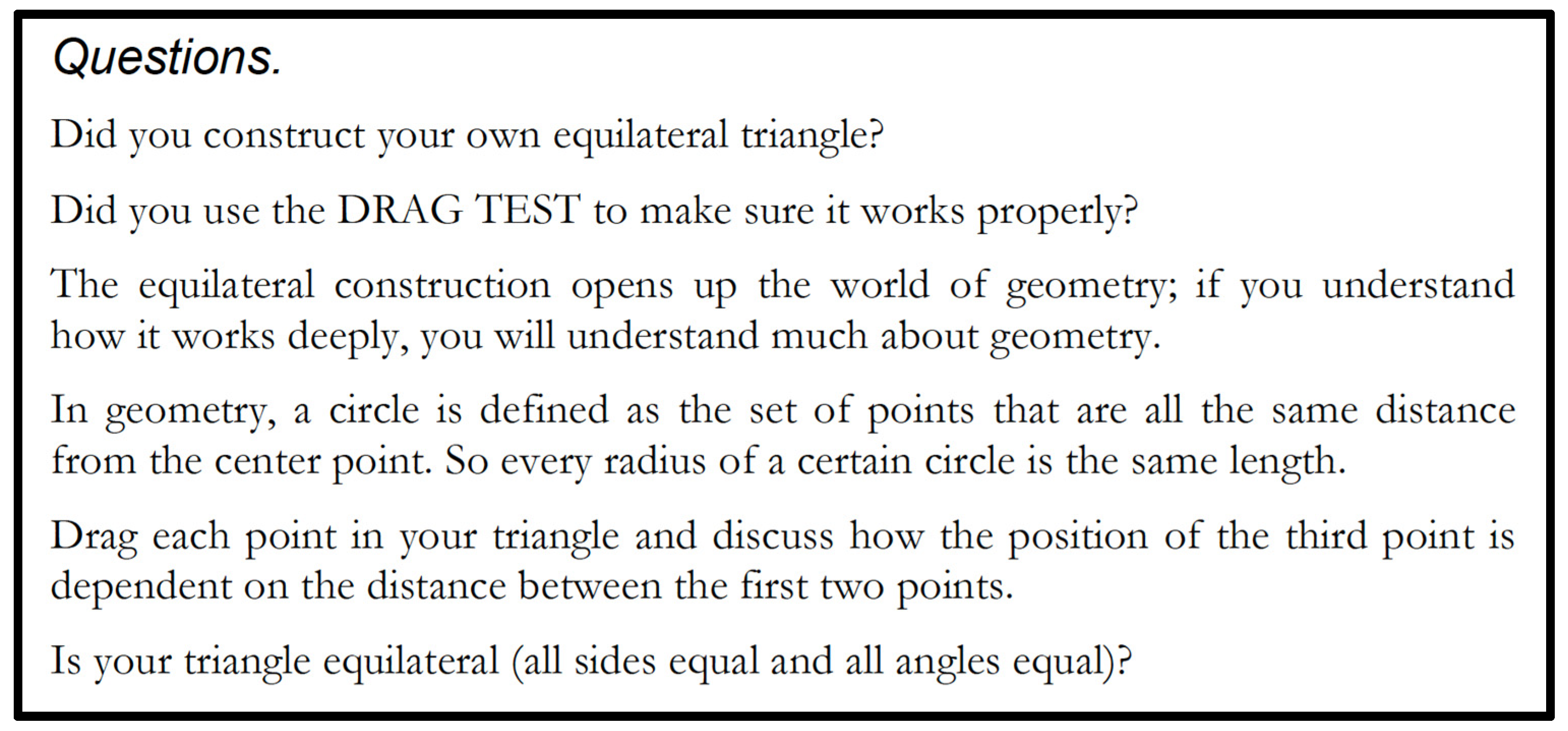Redesigning Mathematical Curriculum for Blended Learning
Abstract
:1. Introduction: Student Pods during the Pandemic
2. Designing for Virtual Math Teams
- First, it generated and collected data on small online groups of public-school students collaborating on problem solving.
- Second, it provided computer support, including a shared whiteboard and a dynamic-geometry app.
- Third, it analyzed the group interaction that unfolded in the team discourse.
- Fourth, it elaborated aspects of a theory of “group cognition” [19]. Several papers published during this period and contributing to the broad vision of CSCL have now been reprinted and reflected upon in Theoretical Investigations: Philosophic Foundations of Group Cognition [11]. Several chapters in this volume analyze aspects of group cognition based on excerpts of student discourses during VMT sessions.
3. Redesigning for Pandemic Pods with GeoGebra Classes
4. Findings from VMT Trials
5. Supporting Group Practices in Blended Learning
6. Broadening the Model for Blended Learning
Funding
Institutional Review Board Statement
Informed Consent Statement
Data Availability Statement
Conflicts of Interest
References
- Sawyer, R.K. Cambridge Handbook of the Learning Sciences, 3rd ed.; Cambridge University Press: Cambridge, UK, 2021. [Google Scholar]
- Sinclair, N. The History of the Geometry Curriculum in the United States, Research in Mathematics Education; Information Age Publishing, Inc.: Charlotte, NC, USA, 2008. [Google Scholar]
- Noor, S.; Isa, F.M.; Mazhar, F.F. Online Teaching Practices During the COVID-19 Pandemic. Educ. Process Int. J. 2020, 9, 169–184. [Google Scholar] [CrossRef]
- Peimani, N.; Kamalipour, H. Online Education and the COVID-19 Outbreak: A Case Study of Online Teaching during Lockdown. Educ. Sci. 2021, 11, 72. [Google Scholar] [CrossRef]
- Blume, C. German Teachers’ Digital Habitus and Their Pandemic Pedagogy. Postdigital Sci. Educ. 2020, 2, 879–905. [Google Scholar] [CrossRef]
- Preez, P.D.; Grange, L.L. The COVID-19 Pandemic, Online Teaching/Learning, the Digital Divide, and Epistemological Access. Available online: alternation.ukzn.ac.za/Files/books/series-01/01/06-Du-Preez.pdf (accessed on 31 March 2021).
- Niemi, H.M.; Kousa, P. A case study of students’ and teachers’ perceptions in a Finnish high school during the COVID pandemic. Int. J. Technol. Educ. Sci. (IJTES) 2020, 4, 352–369. [Google Scholar] [CrossRef]
- Tartavulea, C.V.; Albu, C.N.; Albu, N.; Dieaconescu, R.I.; Petre, S. Online Teaching Practices and the Effectiveness of the Educational Process in the Wake of the COVID-19 Pandemic. Amfiteatru Econ. 2020, 22, 920–936. [Google Scholar] [CrossRef]
- Stahl, G.; Koschmann, T.; Suthers, D. Computer-supported collaborative learning. In Cambridge Handbook of the Learning Sciences, 3rd ed.; Sawyer, R.K., Ed.; Cambridge University Press: Cambridge, UK, 2021. [Google Scholar]
- Cress, U.; Rosé, C.; Wise, A.; Oshima, J. International Handbook of Computer-Supported Collaborative Learning; Springer: New York, NY, USA, 2021. [Google Scholar]
- Stahl, G. Theoretical Investigations: Philosophical Foundations of Group Cognition, Computer-Supported Collaborative Learning Series #18; Springer: New York, NY, USA, 2021. [Google Scholar]
- Johnson, N.; Veletsianos, G.; Seaman, J. U.S. faculty and administrators’ experiences and approaches in the early weeks of the COVID-19 pandemic. Online Learn. 2020, 24, 6–21. [Google Scholar] [CrossRef]
- Adedoyin, O.B.; Soykan, E. Covid-19 pandemic and online learning: The challenges and opportunities, Interactive Learning Environments. Interact. Learn. Environ. 2020, 1–3. [Google Scholar] [CrossRef]
- Busto, S.; Dumbser, M.; Gaburro, E. A Simple but Efficient Concept of Blended Teaching of Mathematics for Engineering Students during the COVID-19 Pandemic. Educ. Sci. 2021, 11, 56. [Google Scholar] [CrossRef]
- Orlov, G.; McKee, D.; Berry, J.; Boyle, A.; DiCiccio, T.; Ransom, T.; Rees-Jones, A.; Stoye, J. Learning during the COVID-19 Pandemic: It Is Not Who You Teach, but How You Teach. Natl. Bur. Econ. Res. 2020. [Google Scholar] [CrossRef]
- Stahl, G. Constructing Dynamic Triangles Together: The Development of Mathematical Group Cognition, Learning in Doing: Social, Cognitive and Computational Perspectives Series; Cambridge University Press: Cambridge, UK, 2016. [Google Scholar]
- Stahl, G. Translating Euclid: Designing a Human-Centered Mathematics, Synthesis Lectures on Human-Centered Informatics Series #17; Morgan & Claypool Publishers: San Rafael, CA, USA, 2013. [Google Scholar]
- Stahl, G. Studying Virtual Math Teams, Computer-Supported Collaborative Learning Series #11; Springer: New York, NY, USA, 2009. [Google Scholar]
- Stahl, G. Group Cognition: Computer Support for Building Collaborative Knowledge, Acting with Technology Series; MIT Press: Cambridge, MA, USA, 2006. [Google Scholar]
- Hölzl, R. How does “dragging” affect the learning of geometry. Int. J. Comput. Math. Learn. 1996, 1, 169–187. [Google Scholar] [CrossRef]
- Jones, K. Coming to know about ‘dependency’ within a dynamic geometry environment. In Proceedings of the 20th Conference of the International Group for the Psychology of Mathematics Education, Valencia, Spain, 8–12 July 1996; Volume 3, pp. 145–152. [Google Scholar]
- Laborde, C. Dynamic geometry environments as a source of rich learning contexts for the complex activity of proving. Educ. Stud. Math. 2000, 44, 151–161. [Google Scholar] [CrossRef]
- Grisi-Dicker, L.; Powell, A.B.; Silverman, J.; Fetter, A. Addressing Transitional Challenges to Teaching with Dynamic Geometry in a Collaborative Online Environment. In Proceedings of the 34th Annual Meeting of the North American Chapter of the International Group for the Psychology of Mathematics Education; Zoest, L.R.V., Lo, J.-J., Kratky, J.L., Eds.; Western Michigan University: Kalamazoo, MI, USA, 2012; pp. 1024–1027. [Google Scholar]
- Sfard, A. Thinking as Communicating: Human Development, the Growth of Discourses and Mathematizing; Cambridge University Press: Cambridge, UK, 2008. [Google Scholar]
- Euclid. Euclid’s Elements; Green Lion Press: Santa Fe, NM, USA, 2002. [Google Scholar]
- Stahl, G. Dynamic Geometry Game for Pods; Lulu: Chatham, MA, USA, 2020; Available online: http://GerryStahl.net/elibrary/game/game.pdf (accessed on 31 March 2021).
- Common Core State Standards for Mathematics; National Governors Association Center for Best Practices and Council of Chief State School Officers: Washington, DC, USA, 2012; Available online: http://www.corestandards.org (accessed on 31 March 2021).
- Medina, R.; Stahl, G. Analysis of Group Practices. In International Handbook of Computer-Supported Collaborative Learning; Cress, U., Rosé, C., Wise, A., Oshima, J., Eds.; Springer: New York, NY, USA, 2021. [Google Scholar]
- Thorndike, E.L. Educational Psychology; Teachers College: New York, NY, USA, 1914; Volume I–III. [Google Scholar]
- Gardner, H. The Mind’s New Science: A History of the Cognitive Revolution; Basic Books: New York, NY, USA, 1985. [Google Scholar]
- Stahl, G.; Hakkarainen, K. Theories of CSCL. In International Handbook of Computer-Supported Collaborative Learning; Cress, U., Rosé, C., Wise, A., Oshima, J., Eds.; Springer: New York, NY, USA, 2021. [Google Scholar]
- Latour, B. On Interobjectivity. Mind Cult. Act. 1996, 3, 228–245. [Google Scholar] [CrossRef]
- Latour, B. The Netz-Works of Greek Deductions. Soc. Stud. Sci. 2008, 38, 441–459. [Google Scholar] [CrossRef]
- Lave, J.; Wenger, E. Situated Learning: Legitimate Peripheral Participation; Cambridge University Press: Cambridge, UK, 1991. [Google Scholar]
- Tomasello, M. A Natural History of Human Thinking; Harvard University Press: Cambridge, MA, USA, 2014. [Google Scholar]
- Vygotsky, L. Mind in Society; Harvard University Press: Cambridge, MA, USA, 1930. [Google Scholar]
- Vygotsky, L. Thought and Language; MIT Press: Cambridge, MA, USA, 1934. [Google Scholar]
- Çakir, M.P.; Zemel, A.; Stahl, G. The joint organization of interaction within a multimodal CSCL medium. Int. J. Comput. Supported Collab. Learn. 2009, 4, 115–149. [Google Scholar] [CrossRef]
- Roschelle, J. Learning by collaborating: Convergent conceptual change. In CSCL: Theory and Practice of an Emerging Paradigm; Koschmann, T., Ed.; Lawrence Erlbaum Associates: Hillsdale, NJ, USA, 1996; pp. 209–248. [Google Scholar]
- Dillenbourg, P.; Nussbaum, M.; Dimitriadis, Y.; Roschelle, J. Design for classroom orchestration. Comput. Educ. 2013, 69, 485–492. [Google Scholar] [CrossRef]
- Stein, M.K.; Engle, R.A.; Smith, M.S.; Hughes, E.K. Orchestrating Productive Mathematical Discussions: Five Practices for Helping Teachers Move Beyond Show and Tell. Math. Think. Learn. 2008, 10, 313–340. [Google Scholar] [CrossRef]




| Group Collaboration Practices: |
| 1. Discursive turn taking (responding to each other and eliciting responses). |
| 2. Coordinating activity (deciding who should take each step). |
| 3. Constituting a collectivity (e.g., using “we” rather than “I” as agent). |
| 4. Sequentiality (establishing meaning by temporal context). |
| 5. Co-presence (being situated together in a shared world of concerns). |
| 6. Joint attention (focus on the same, shared images, words and actions). |
| 7. Opening and closing topics (changing discourse topics together). |
| 8. Interpersonal temporality (recognizing the same sequence of topics, etc.). |
| 9. Shared understanding (common ground). |
| 10. Repair of understanding problems (explicitly fixing misunderstandings). |
| 11. Indexicality (referencing the same things with their discourse). |
| 12. Use of new terminology (adopting new shared words). |
| 13. Group agency (deciding what to do as a group). |
| 14. Sociality (maintaining friendly relations). |
| 15. Intersubjectivity (sharing perspectives). |
| Group Dragging Practices: |
| 1. Do not drag lines to visually coincide with existing points, but use the points to construct lines between or through them. |
| 2. Observe visible feedback from the software to guide dragging and construction. |
| 3. Drag points to test if geometric relationships are maintained. |
| 4. Drag geometric objects to observe invariances. |
| 5. Drag geometric objects to vary the figures and see if relationships are always maintained. |
| 6. Some points cannot be dragged or only dragged to a limited extent; they are constrained. |
| Group Construction Practices: |
| 1. Reproduce a figure by following instruction steps. |
| 2. Draw a figure by dragging objects to appear right. |
| 3. Draw a figure by dragging objects and then measure to check. |
| 4. Draw a figure by dragging objects to align with a standard. |
| 5. Construct equal lengths using radii of circles. |
| 6. Use previous construction practices to solve new problems. |
| 7. Construct an object using existing points to define the object by those points. |
| 8. Discuss geometric relationships as results of the construction process. |
| 9. Check a construction by dragging its points to test if relationships remain invariant. |
| Group Tool-Usage Practices: |
| 1. Use two points to define a line or segment. |
| 2. Use special GeoGebra tools to construct perpendicular lines. |
| 3. Use custom tools to reproduce constructed figures. |
| 4. Use the drag test to check constructions for invariants resulting from custom tools. |
| Group Dependency-Related Practices: |
| 1. Drag the vertices of a figure to explore its invariants and their dependencies. |
| 2. Construct an equilateral triangle with two sides having lengths dependent on the length of the base, by using circles to define the dependency. |
| 3. Circles that define dependencies can be hidden from view, but not deleted, and still maintain the dependencies. |
| 4. Construct a point confined to a segment by creating a point on the segment. |
| 5. Construct dependencies by identifying relationships among objects, such as segments that must be the same length. |
| 6. Construct an inscribed triangle using the compass tool to make distances to the three vertices dependent on each other. |
| 7. Use the drag test to check constructions for invariants. |
| 8. Discuss relationships among a figure’s objects to identify the need for construction of dependencies. |
| 9. Points in GeoGebra are colored differently if they are free, restricted or dependent. |
| 10. Indications of dependency imply the existence of constructions (such as regular circles or compass circles) that maintain the dependencies, even if the construction objects are hidden. |
| 11. Construct a square with two perpendiculars to the base with lengths dependent on the length of the base. |
| 12. Construct an inscribed square using the compass tool to make distances on the four sides dependent on each other. |
| 13. Use the drag test routinely to check constructions for invariants. |
| Group Practices Using Chat and GeoGebra Actions: |
| 1. Identify a specific figure for analysis. |
| 2. Reference a geometric object by the letters labeling its vertices or defining points. |
| 3. Vary a figure to expand the generality of observations to a range of variations |
| 4. Drag vertices to explore what relationships are invariant when objects are moved, rotated, extended. |
| 5. Drag vertices to explore what objects are dependent upon the positions of other objects. |
| 6. Notice interesting behaviors of mathematical objects |
| 7. Use precise mathematical terminology to describe objects and their behaviors. |
| 8. Discuss observations, conjectures and proposals to clarify and examine them |
| 9. Discuss the design of dependencies needed to construct figures with specific invariants. |
| 10. Use discourse to focus joint attention and to point to visual details. |
| 11. Bridge to past related experiences and situate them in the present context. |
| 12. Wonder, conjecture, propose. Use these to guide exploration. |
| 13. Display geometric relationships by dragging to reveal and communicate complex behaviors. |
| 14. Design a sequence of construction steps that would result in desired dependencies. |
| 15. Drag to test conjectures. |
| 16. Construct a designed figure to test the design of dependencies. |
Publisher’s Note: MDPI stays neutral with regard to jurisdictional claims in published maps and institutional affiliations. |
© 2021 by the author. Licensee MDPI, Basel, Switzerland. This article is an open access article distributed under the terms and conditions of the Creative Commons Attribution (CC BY) license (https://creativecommons.org/licenses/by/4.0/).
Share and Cite
Stahl, G. Redesigning Mathematical Curriculum for Blended Learning. Educ. Sci. 2021, 11, 165. https://doi.org/10.3390/educsci11040165
Stahl G. Redesigning Mathematical Curriculum for Blended Learning. Education Sciences. 2021; 11(4):165. https://doi.org/10.3390/educsci11040165
Chicago/Turabian StyleStahl, Gerry. 2021. "Redesigning Mathematical Curriculum for Blended Learning" Education Sciences 11, no. 4: 165. https://doi.org/10.3390/educsci11040165
APA StyleStahl, G. (2021). Redesigning Mathematical Curriculum for Blended Learning. Education Sciences, 11(4), 165. https://doi.org/10.3390/educsci11040165





